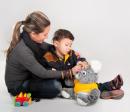- The Wonderful Sound of Words
Cuba’s Cochlear Implant Program celebrated its 20th anniversary in 2017. Successfully and prestigiously positioned at international level, the Cuban program is mainly focused on the pediatric age because of its long-term impact. It treats both deaf and deaf-blind children.
In fact, it is the Latin American nation with the highest number of treated deaf-blind patients. This is the perfect age, since they can make the most of the language and neurologic development stage. The procedure involves several important stages. That is the opinion of Dr. Beatriz Bermejo, who stresses that “you cannot get one without the other. Results depend on all of them. The stages are: Candidate Selection, Assessment and Decision-making, Surgery, Scheduling and, finally, Patient Rehabilitation.”
A few years ago, most of children born and suffering from profound deafness had limited oral expression development. However, thanks to the development of pediatric cochlear implants the situation is presently favorable. They provide notable improvements in terms of perception, language development and intelligibility, with the resulting positive impact on patient’s neurodevelopment.
The cochlear implant is an electronic device that has been scientifically tested and approved to treat children who suffer from severe-to-profound sensorineural hearing loss in both ears.
“This device is surgically connected to the inner ear. It turns sounds into electric energy that is received by the cochlear nerve input, thus triggering an auditory sensation in the patient. It is made up of an external device and an internal element. The latter is surgically installed. The external components include a microphone located behind the ear, a speech processor and a transmitter attached to the scalp behind the ear. As for internal components, it includes a receiver, a magnet under the ear skin and wired electrodes in the cochlea.”
Dr. Bermejo points out that the creation of these implants has revolutionized the treatment to deaf children by helping them develop functional hearing. The level of oral language development in most of these cases is very similar to hearing children.
“Nowadays, these implants are connected to cellphones, via Bluetooth, and TV sets. Patients can listen to music, enjoy swimming pools and the beach, and the implants feature a connectivity system that improves the interaction with their teachers. We get the devices from two of the best companies of the world in this field: Cochlear and Advanced Bionics. The sooner the implant is in place, the bigger the impact. It is recommended to go through this process before the age of two, since the activation accelerates vocal development and increases the number of vocalizations.
But having the implant is not enough. The device does not give children their auditory function at once. That is when rehabilitation comes into stage, “the longest and most satisfying phase because you can see the achievements. You get to see how children carrying the implant grow, become university graduates and play social roles.”
The brain needs to be trained so it learns how to understand sound obtained through a cochlear implant. This stage combines language rehabilitation with the natural environment in the facility; communicative and language skills are assessed by applying standardized scales, individual and group therapy sessions are given, families are advised on the handling and maintenance of the equipment. Moreover, professionals are trained on this matter and the learning of auditory, language and oral skills in order to help children.
So far, after rehabilitation, over 66 percent of treated children have passed to identification-recognition-comprehension levels with bimodal oral communication.
“Such factors as children’s age, family, motivation and intelligence are taken into account when designing rehabilitation programs. There are different techniques: verbal auditory therapy program with environmental stimulus by hearing, which means that no gesture system or lip-reading is used. For bigger or smaller children that cannot be included in this type of therapy, we have an oral auditory therapy program, where we use gestures, sign language, lip reading; all visual elements. We later work on the auditory system to develop language. It is generally used in school children that have an established communication code and they are going to start hearing again.”
Over 250,000 patients around the world carry a cochlear implant. Out of this figure, 100,000 are children. In Cuba, 430 patients use cochlear implants. The professionals working on this program collaborate with specialists in otosurgery, audiology, psychology, neurophysiology and pediatrics from Cuba and the world. Some 300 people have been rehabilitated with this service to date, including patients from Venezuela, Dominican Republic, Angola and Haiti.
La Pradera International Healthcare Center has 20 years of experience in treating children with hearing impairment and language disorders. Its professionals are highly qualified to provide an array of speech rehabilitation therapies. The activity is guided by a specialist in speech therapy, who assesses, diagnoses and specifies the intervention program to be use with each child, by taking into account individual characteristics and family and school environment.
“It has been a challenge in my professional life. It is great to walk with these children and their parents, enjoying every smile and every word,” Dr. Beatriz Bermejo Guerra said.








































